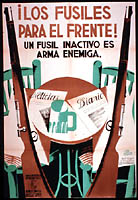 |
¡Los fusiles para el frente! Un fusil inactivo es un arma enemiga
[Rifles for the front! An inactive rifle is an enemy weapon]. Signed: Juan Antonio Morales. Ministerio de Instrucción Púlica. Dirección Gral. de Bellas Artes. Asociación de Obreros Litógrafos, U.G.T. Lito. Fernández. Lithograph, 3 colors; 100 x 70 cm.
|
|
Two Gewehr 98 rifles
are set against two chairs and take on the role of patrons in a
cafe; on the table in the center of the scene are a large beer mug
and two newspapers generically titled Noticias (News) and Diario
(Journal). The image illustrates the inscription on the poster:
the two guns are wasted by remaining idle instead of being used
in the front. By depicting the guns as human figures, the artist
calls attention not only to the inactive rifles, but also to those
responsible for their improper use.
This poster reflects
a serious problem that occurred in Republican Spain during the war.
Immediately after the outbreak of the war in July 1936, weapons
were distributed to the civilian population. This drastic measure
allowed the Republic to successfully hold back the military rebellion
in many areas of Spain, but it also caused difficulties. Guns were
sometimes ostentatiously carried in public as objects that conferred
status upon those who owned them. As Hugh Thomas, describing life
in Madrid at the beginning of the war, has put it: "Rifles
were carried (wasted, rather) as symbols of revolution." This
kind of behavior caused the government to campaign so that guns
would be used exclusively for the war.
The stamp on the lower
left corner of this poster indicates that it was issued by the Dirección
General de Bellas Artes, an agency of the Ministry of Public Instruction
that was active in the production of propaganda during the war.
Like many of the posters issued by the ministry, this one can tentatively
be dated between early September, 1936, and November 6 of the same
year, when the government of the Republic left Madrid for Valencia.
The author of this image is the painter Juan Antonio Morales (Villavaquerín
del Cerrato, Valladolid, 1909-Madrid, 1984). Morales divided his
youth between Spain and Cuba before establishing his residency in
Madrid in 1931. He studied with one of Spain's leading painters,
Daniel Vázquez Díaz, and in the early 1930s developed
a style close to Surrealism. At that time, Morales also collaborated
with García Lorca in the theater group La Barraca. During
the war, Morales fought on the Republican side and collaborated
with leading left-wing organizations and journals. In 1936, he illustrated
an edition of García Lorca's Romancero Gitano as well as
the book Crónica del Pueblo en Armas by another of Spain's
leading writers, Ramón J. Sender. He also designed propaganda
posters such as this one and the famous Los Nacionales. Morales'
style in these and other works produced during the war is remarkably
varied: in this poster, he draws his inspiration from the language
of cubist still-life compositions, while the poster Los Nacionales
is a caricature. His illustrations for the books of García
Lorca and Sender are more realistic and are probably inspired by
the influential neo-classical style used by Picasso in the late
1910s and the early and mid-1920s. After the war, Morales was arrested
in Alicante. He was court-martialed and was absolved in 1940.
|




